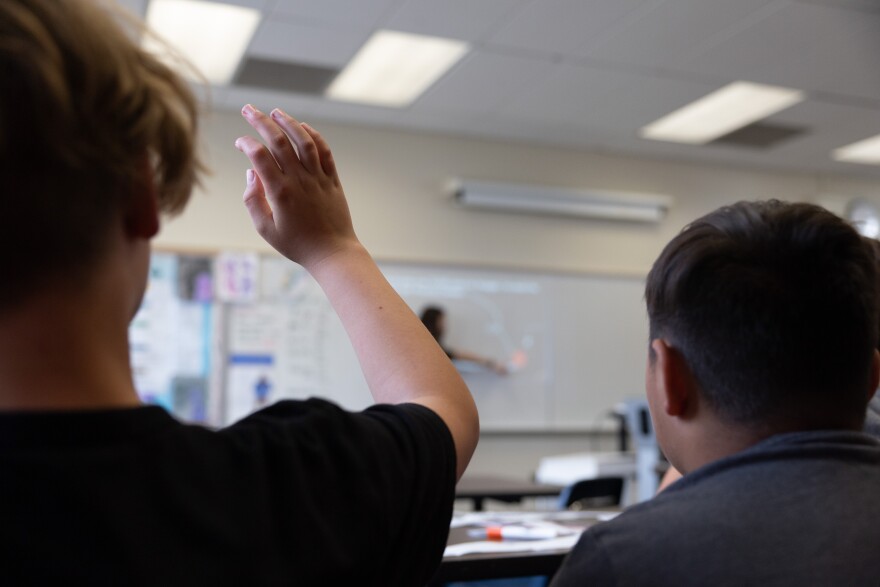Truth matters. Community matters. Your support makes both possible. LAist is one of the few places where news remains independent and free from political and corporate influence. Stand up for truth and for LAist. Make your year-end tax-deductible gift now.
Pandemic recovery continues, but students still lag behind 2019 test scores

While California students — and those across the country — have not reached prepandemic math and reading scores, some individual districts are showing signs of recovery.
The latest findings from a Harvard, Stanford and Dartmouth College research project land as districts continue to grapple with the loss of pandemic relief money and the uncertainty of a presidential administration that’s promised dramatic cuts to the country’s education agency.
The project’s researchers said that overall, reading scores continued to decline since 2019, and that there was a little bit of recovery in math.
“Overall, the story isn't great,” said Stanford Graduate School of Education Professor Sean Reardon. “That said, there are some bright spots.”
California students have improved more quickly than the national average, but the average student is still about one-third of a grade level behind in math and about 40% of a grade level behind in reading compared to 2019.
Some districts have exceeded prepandemic test scores — 10% of California students attend districts that scored higher in math and reading in 2024 than they did in 2019.
Many more showed gains in a single subject. For example, Los Angeles Unified School District’s math scores improved while reading performance dipped slightly.
“We are fully aware there is more work to do, and we will not cease momentum until every student reaches their full potential,” LAUSD Superintendent Alberto Carvalho said in a statement. “But these results are a clear reflection of our work, and it is truly a bright spot after years of adversity.”
Another example: Compton Unified, for reading. Researchers pointed to the district’s expanded after-school, weekend and summer learning programs as successful recovery strategies.
What parents need to know
The Education Recovery Scorecard combines federal and state standardized test results in grades 3 through 8 to show how student outcomes changed from 2019 to spring 2024.
Researchers looked at two sets of test results in California:
- National Assessment of Educational Progress: an every-other-year reading and math test, also known as the Nation's Report Card, given to a representative group of fourth-, eighth- and 12th-graders in every state.
- Smarter Balanced Assessment: A reading and math test given annually to California students in grades 3 through 8 and when they’re a junior in high school.
While the scorecard does not track an individual student’s academic growth, it provides families a window into how students are learning across the school district.
For example, if students overall are significantly behind grade-level on math, families might consider seeking out additional tutoring or requesting more support through the school.
“It's not just a pandemic recovery issue,” Reardon said. “I think it's part of a broader issue about how we support and improve our public school system going forward.”
Are California students showing up to school?
A student is considered “chronically absent” when they miss 10%— about a month— or more of school a year. In the 2023-2024 school year about 19% of California students in grades K-8 were chronically absent; that’s down from a peak of 30% during the pandemic, but still higher than before the pandemic.
Here are the most recent chronic absenteeism rates from the area’s largest school districts:
Ongoing challenges
The data shows that the achievement gap between affluent, predominantly white school districts and those that serve primarily low-income students of color continues to widen.
Researchers suggest that a high rate of student absences, particularly in low-income school districts, has slowed academic recovery.
One challenge is that many parents don’t cite chronic absenteeism as a major concern.
Educators say the harm is twofold — absent students miss hours of classroom instruction, and teachers may have to adjust their lessons to help students catch up.
“That not only hurts the student who's missed something, but it also means that the students who didn't miss the last few days aren't getting as much opportunity to learn new material,” Reardon said.
Another challenge is the end of billions of dollars in federal and state pandemic aid. The scorecard found that those dollars were associated with higher test scores, particularly in higher poverty districts.
In California, researchers could track whether the money was spent on academic catch-up.
“The more they spent on the academic efforts, the bigger the recovery,” Reardon said.








